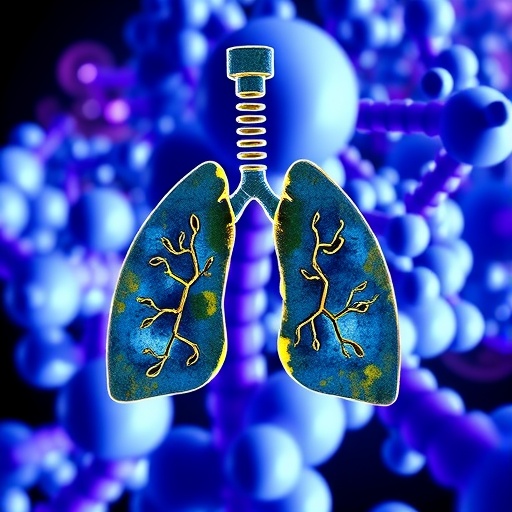In a groundbreaking study published in BMC Cancer, researchers have demonstrated the clinical utility and robust performance of a circulating tumor DNA (ctDNA)-based next-generation sequencing (NGS) platform in patients with stage III and IV non-small cell lung cancer (NSCLC) within a large Chinese cohort. This investigation represents a significant advancement in liquid biopsy technology, offering a viable alternative to tissue-based genomic profiling that guides personalized treatment in advanced NSCLC.
Liquid biopsy utilizing ctDNA has emerged as a minimally invasive method for molecular characterization of tumors, essential for identifying actionable mutations that drive targeted therapies. Unlike traditional tissue biopsies, which are often limited by sample accessibility or tumor heterogeneity, ctDNA assays offer the potential to capture a real-time snapshot of the tumor’s genetic landscape through blood samples. However, clinical validation of such NGS platforms, especially in advanced NSCLC, has remained sparse—until now.
The study meticulously defined the assay’s limit of detection and quality control parameters employing plasma samples from NSCLC patients, using droplet digital PCR (ddPCR) as a stringent reference standard. By employing receiver operating characteristic (ROC) curves and downsampling techniques, the researchers established a detection threshold at 0.2% variant allele frequency and set a critical sequencing quality benchmark at over 1400x mean effective coverage. These rigorous parameters ensured reliable mutation detection sensitivity and specificity.
Validation in an independent cohort of 522 samples underscored the assay’s accuracy, with ddPCR comparisons revealing over 80% positive percentage agreement (PPA) and over 95% negative percentage agreement (NPA). This high concordance between NGS and ddPCR reinforces the platform’s technical reliability in detecting clinically relevant mutations from plasma DNA, enhancing confidence for therapeutic decision-making.
Utilizing a focused 21-gene panel, the ctDNA NGS assay detected mutations in approximately 74% of patients, with nearly half bearing mutations deemed targetable according to the National Comprehensive Cancer Network (NCCN) guidelines. These actionable alterations pave the way for applying precision oncology strategies tailored to individual tumor genotypes, potentially improving patient outcomes by informing targeted therapy choices.
An in-depth concordance analysis between plasma and tissue samples uncovered stage-dependent performance disparities. For stage III patients, positive concordance was modest at roughly 29%, although negative concordance remained high at around 99%, indicating fewer false positives. In contrast, stage IV patients exhibited exceptional agreement in both positive and negative mutation calls, exceeding 99%. This stage variation suggests ctDNA is a more reliable biomarker in late-stage disease when tumor DNA is more abundantly shed into circulation.
Importantly, the study highlighted plasma-specific mutations with clinical relevance that were not detected in tissue biopsies, underscoring the ability of liquid biopsy to capture tumor heterogeneity and emerging resistance mechanisms that may evolve during disease progression or therapy. This points towards ctDNA NGS not only as a diagnostic tool but also as a means to monitor dynamic tumor genomics longitudinally.
Clinical outcome data from pooled analyses demonstrated that responses to targeted therapies guided by plasma-based ctDNA sequencing were comparable to those based on conventional, tissue-based National Medical Products Administration (NMPA)-approved assays. This equivalence reinforces ctDNA NGS as a practical clinical companion diagnostic, enabling oncologists to make informed treatment decisions when tissue samples are inadequate or inaccessible.
The implementation of this ctDNA NGS platform in a real-world Chinese population provides compelling evidence for integrating liquid biopsy into routine clinical workflows for stage III/IV NSCLC management. It offers a rapid, less invasive, and equally informative approach to tumor genotyping, which is crucial for the timely initiation of personalized therapies in advanced lung cancer.
Beyond technical and clinical validation, the study’s comprehensive approach—including setting precise quality controls, validating against gold-standard methods, and analyzing extensive patient datasets—sets a benchmark for future liquid biopsy assay development. It illustrates how rigorous methodological standards can propel innovative diagnostic tools from bench to bedside.
This work also underscores the importance of cohort-specific validation, considering genetic backgrounds and disease characteristics that may differ across populations. The success in a large Chinese cohort affirms the assay’s applicability in diverse demographic contexts and supports broader international adoption.
Such advancements are particularly significant given the challenges posed by NSCLC’s molecular complexity and the critical need for non-invasive, real-time monitoring of treatment response and resistance. Liquid biopsy-based NGS stands poised to revolutionize lung cancer care by facilitating personalized medicine with greater precision and patient convenience.
In conclusion, the study published in BMC Cancer paves the way for ctDNA-based NGS to become a cornerstone in the clinical management of advanced NSCLC. By delivering accurate, clinically actionable genomic profiles through a minimally invasive blood test, this technology promises to enhance therapeutic decision-making and ultimately improve survival outcomes for patients facing this formidable disease.
Trial registration details emphasize the study’s rigor and transparency, having been registered with the Chinese Clinical Trial Registry (ChiCTR2000041034) in December 2020. Such formal oversight underlines the clinical relevance and methodological soundness of the findings.
As precision oncology continues to evolve, integrating liquid biopsy NGS assays validated in real-world cohorts will be key for expanding access to cutting-edge molecular diagnostics. This study exemplifies how technological innovation, combined with clinician-researcher collaboration, can transform cancer care paradigms and bring personalized treatment closer to patients worldwide.
Subject of Research: Liquid biopsy next-generation sequencing (NGS) for mutational profiling in stage III/IV non-small cell lung cancer (NSCLC) patients.
Article Title: Implementing liquid biopsy NGS in stage III/IV NSCLC: clinical utility assessment from a real-world Chinese cohort.
Article References:
Yang, X., Gao, S., Ju, R. et al. Implementing liquid biopsy NGS in stage III/IV NSCLC: clinical utility assessment from a real-world Chinese cohort. BMC Cancer 25, 1765 (2025). https://doi.org/10.1186/s12885-025-15227-0
Image Credits: Scienmag.com
DOI: 10.1186/s12885-025-15227-0
Keywords: Liquid biopsy, ctDNA, next-generation sequencing, non-small cell lung cancer, NSCLC, stage III/IV, clinical utility, mutation detection, precision oncology, targeted therapy, tumor heterogeneity, plasma DNA, genomic profiling, Chinese cohort




